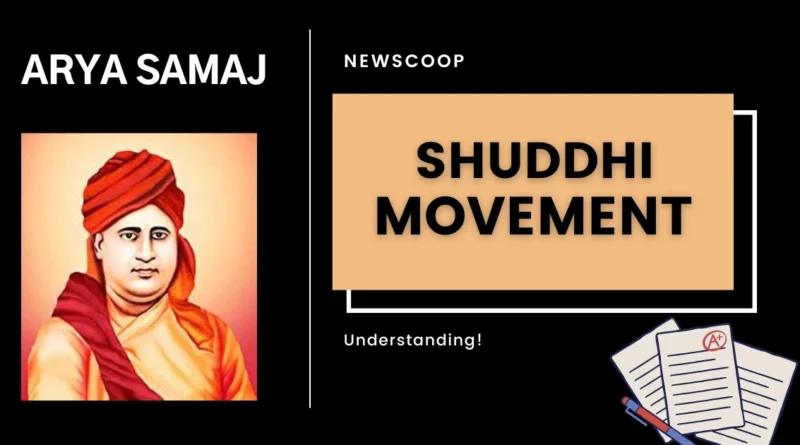Shuddhi Movement: Facts of Sangathan Andolan
What is the Shuddhi Movement?
The Shuddhi Movement was a socio-religious movement that took place in India in the early part of the 20th century. It was started by the Arya Samaj with the aim of bringing back people who had converted to Islam and Christianity from Hinduism. The word ‘Shuddhi’ means purification, but in this context, it refers to the process of reconverting individuals from other religions to Hinduism.
| Movement | Shuddhi Movement |
| Started by | Arya Samaj |
| Objective | Bringing back to Hinduism |
| Method | Sangathan movement |
| Started in | 20th Century |
Background & Context
During the 19th century, India witnessed the rise of several socio-religious reform movements. One of the most prominent among them was the Arya Samaj, which was founded by Swami Dayananda Saraswati in 1875. The Arya Samaj aimed to purify Hinduism by going back to its ancient texts, the Vedas, and rejecting what it saw as later corruptions.
The 19th century also witnessed a significant number of conversions from Hinduism to Islam and Christianity. The reasons for these conversions were diverse, ranging from economic incentives to social discrimination and cultural marginalization. The British colonial rule in India played a significant role in this process, as it encouraged the spread of Christianity and facilitated conversions.
The Shuddhi Movement emerged as a response to this trend of conversion. It aimed to reconquer the lost territory of Hinduism by bringing back the converts to the fold. However, the movement was not merely an attempt at reconversion. It also had a broader social reform agenda.
Objectives of the Shuddhi Movement
- To bring back the people who converted to Islam and Christianity back to Hinduism through reconversion or Shuddhi.
- To promote the idea of Hindu unity and mobilize the Hindus in support of the broader Hindu cause.
- To abolish the practice of untouchability and integrate outcasts from other religions into the mainstream Hindu community.
- To reduce the conversions of Hindus to Islam and Christianity by educating the Hindus about the true nature of their religion.
- To give the Vedas the same degree of supernatural authority as the Koran and Bible claimed by Islam and Christianity.
- To establish the social and cultural superiority of Hinduism over other religions.
- To counter the influence of the Muslim League and promote the interests of the Hindus in the political landscape of India.
- To revive the glory and purity of ancient Hindu traditions and customs.
- To promote social reform and remove the perceived evils in Hindu society.
- To restore the pride and self-confidence of the Hindu community.
Methods of the Shuddhi Movement
The Shuddhi Movement used several methods to achieve its objectives. One of the most prominent methods was the Sangathan movement. The Sangathan movement aimed to organize the Hindus and mobilize them in support of the Shuddhi cause. The movement organized rallies, processions, and public meetings to raise awareness about the need for Shuddhi.
The movement also used propaganda to counter the propaganda of the Christian missionaries. The Arya Samaj published several pamphlets and books that aimed to educate the Hindus about the true nature of their religion and the fallacies of the other religions. The movement also established schools and colleges to provide education to the Hindus and to counter the Christian missionary schools.
The Shuddhi movement also used aggressive tactics to achieve its objectives. Swami Shraddhanand founded the ‘Bhartiya Hindu Shuddhi Mahasabha’ (Indian Hindu Purification Council) in 1923 and pushed the agenda of reconversion aggressively. This approach created a flashpoint between Hindus and Muslims, as the Muslims saw the movement as a threat to their religion and their community. The Shuddhi movement faced resistance from the Muslim community, which viewed it as an attempt to undermine their religion and their identity.
The movement also faced opposition from other Hindu groups who saw the Shuddhi movement as divisive and harmful to the broader Hindu community. These groups believed that the move would lead to more conflicts between the Hindus and Muslims and that it would create more divisions within the Hindu community.
What is the Sangathan movement?
The Sangathan movement was a socio-political movement in India that aimed to create solidarity and unity among Hindus, particularly in response to communal conflicts between Hindus and Muslims. It sought to bring Hindus together and strengthen their collective identity, fostering a sense of unity and shared purpose.
The movement was a response to the socio-political challenges faced by the Hindu community during a period of significant religious and political change in India. The Sangathan movement encouraged Hindus to come together and work collectively to protect their interests and promote their cultural and religious values.
While the Sangathan movement was primarily focused on Hindu solidarity, it’s important to note that it was part of a larger historical context characterized by various socio-religious movements in India during the early to mid-20th century. These movements were influenced by a range of factors, including religious, cultural, and political considerations.
Impact of the Shuddhi Movement
- The Shuddhi Movement contributed to the rise of Hindu nationalism and the emergence of the Hindu Mahasabha, a right-wing political party that advocated for the interests of the Hindus.
- The movement promoted the idea of Hindu unity and mobilized the Hindus in support of the broader Hindu cause, which helped to strengthen the Hindu community and increase their political power.
- The Shuddhi Movement also had a negative impact on communal relations between Hindus and Muslims. The reconversion campaigns often led to violent clashes between the two communities, which contributed to the rise of communal violence in India.
- The movement’s aggressive tactics and propaganda contributed to the polarization of Indian society along religious lines, which had a lasting impact on the social fabric of the country.
- The Shuddhi Movement helped to reduce the conversions of Hindus to Islam and Christianity by educating the Hindus about the true nature of their religion and by promoting the superiority of Hinduism over other religions.
- The movement’s social reform agenda helped to promote the abolition of the practice of untouchability and the integration of outcasts from other religions into the mainstream Hindu community, which helped to reduce social inequality and promote social harmony.
- The Shuddhi Movement helped to revive the glory and purity of ancient Hindu traditions and customs, which had a lasting impact on the cultural landscape of India.
- The movement’s promotion of the Vedas as a source of supernatural authority helped to establish the Vedas as the central religious text of Hinduism, which had a lasting impact on the religious traditions of the country.
- The Shuddhi Movement contributed to the emergence of a new wave of Hindu activism, which sought to promote the interests of the Hindus and counter the perceived threats from other religions.
Conclusion
The Shuddhi Movement was a socio-religious movement that aimed to bring back the converts to Islam and Christianity to Hinduism. The movement had a social reform agenda and aimed to abolish the practice of untouchability by integrating the outcasts from other religions into the mainstream community.
The movement also aimed to reduce the conversion of Hindus to Islam and Christianity by educating the Hindus about the true nature of their religion. The movement used several methods, including the Sangathan movement, propaganda, and aggressive tactics, to achieve its objectives. The movement had a significant impact on Indian society, promoting the idea of Hindu unity and mobilizing the Hindus in support of the broader Hindu cause.
However, the movement also had a negative impact on the communal relations between Hindus and Muslims and contributed to the rise of communal violence in India.
Thank You!
FAQs
What is the Shuddhi Movement?
The Shuddhi Movement was a Hindu reform movement in India during the early 20th century. It aimed to “purify” or “reconvert” individuals who had previously converted to other religions, particularly Islam and Christianity, back to Hinduism.
What is the Sangathan movement?
The Sangathan movement was a Hindu socio-political effort to foster unity and solidarity in response to communal conflicts, aiming to strengthen the collective identity of Hindus in India.
Who started the Shuddhi movement?
The Shuddhi Movement was indeed initiated by the Arya Samaj, a Hindu reformist organization founded by Swami Dayananda Saraswati in the late 19th century.
Related Links:

